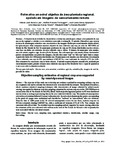Use este identificador para citar ou linkar para este item:
http://www.alice.cnptia.embrapa.br/alice/handle/doc/941717| Título: | Estimativa amostral objetiva de área plantada regional, apoiada em imagens de sensoriamento remoto. |
| Autoria: | LUIZ, A. J. B.  FORMAGGIO, A. R.   EPIPHANIO, J. C. N.   ARENAS-TOLEDO, J. M   GOLTZ, E.   BRANDÃO, D.   |
| Afiliação: | ALFREDO JOSE BARRETO LUIZ, CNPMA; ANTONIO ROBERTO FORMAGGIO, INPE; JOSE CARLOS NEVES EPIPHANIO, INPE; JOHN MAURICIO ARENAS-TOLEDO, Louis Dreyfus Commodities Brasil; ELIZABETH GOLTZ, INPE; DANIELA BRANDÃO, INPE. |
| Ano de publicação: | 2012 |
| Referência: | Pesquisa Agropecuária Brasileira, Brasília, DF, v. 47, n. 9, p. 1279-1287, 2012. |
| Conteúdo: | Resumo: O objetivo deste trabalho foi desenvolver e avaliar um método para estimar a área plantada de soja em escala regional e calcular o erro estatístico associado à estimação. O método (Geosafras), que associa técnicas de amostragem estatística com características das imagens obtidas por sensoriamento remoto orbital, foi aplicado para obter estimativa amostral objetiva da área cultivada com soja, na safra de 2005/2006, no Estado do Rio Grande do Sul. Os municípios produtores de soja, no RS, foram distribuídos em dez estratos, com base em dados pré‐existentes de área cultivada com a cultura. O número de municípios selecionados, em cada estrato, seguiu a regra de alocação de Neyman. Em cada município selecionado, foram aleatorizados pontos correspondentes aos pixels das imagens, classificados como ?soja? ou ?não soja? após visita a campo. A partir dos dados de 3.000 pontos distribuídos nos 30 municípios selecionados, nos dez estratos, foi estimada a área cultivada com soja no RS, que totalizou 4.069.887 ha, com coeficiente de variação (CV) de 3,4%. Esta estimativa foi consistente com os dados oficiais. O método amostral objetivo estratificado, auxiliado por sensoriamento remoto, permite estimar a área cultivada com soja no Rio Grande do Sul e é capaz de quantificar o erro associado à estimativa realizada. Abstract: The objective of this work was to develop and evaluate a method for estimating soybean crop area on a regional scale and to calculate the statistical error associated with the estimate. The method (Geosafras), which combines statistical sampling techniques with characteristics of images obtained by orbital remote sensing, was applied to obtain an objective sampling estimation for soybean crop area in the 2005/2006 harvest season in the state of Rio Grande do Sul (RS), Brazil. Soybean-producing municipalities in RS were distributed into ten strata according to preexisting data on the area cultivated with the crop. The number of municipalities selected in each stratum followed Neyman's allocation rule. In each selected municipality, points corresponding to the pixels of images were randomized and classified as "soybean" or "non-soybean" after site visitation. From the data of 3,000 points in the 30 selected municipalities across the ten strata, soybean crop area in RS was estimated, totaling 4,069,887 ha, with a coefficient of variation (CV) of 3.4%. This estimate was consistent with official data. The stratified objective sampling method, supported by remote sensing, allows for the estimation of the area cultivated with soybean in the state of Rio Grande do Sul and is able to quantify the error associated with the calculated estimate. |
| Thesagro: | Glycine max Soja Estatística agrícola Previsão de safra Sensoriamento remoto |
| NAL Thesaurus: | Agricultural forecasts Agricultural statistics Remote sensing |
| Palavras-chave: | Erro amostral Imagem de satélite Estratificação Soybean |
| Tipo do material: | Artigo de periódico |
| Acesso: | openAccess |
| Aparece nas coleções: | Artigo em periódico indexado (CNPMA)  |
Arquivos associados a este item:
| Arquivo | Descrição | Tamanho | Formato | |
|---|---|---|---|---|
| 2012AP39.pdf | 1.64 MB | Adobe PDF |  Visualizar/Abrir |









